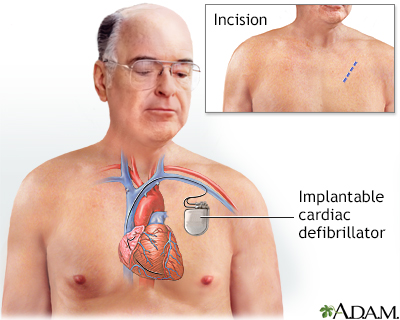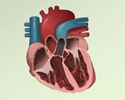Ventricular tachycardia
Wide-complex tachycardia; V tach; Tachycardia - ventricularVentricular tachycardia (VT) is a rapid heartbeat that starts in the lower chambers of the heart (ventricles).
Causes
VT is a pulse rate of more than 100 beats per minute, with at least 3 abnormal rapid heartbeats in a row.
The condition can develop as an early or late complication of a heart attack. It may also occur in people with:
Heart attack
Most heart attacks are caused by a blood clot that blocks one of the coronary arteries. The coronary arteries bring blood and oxygen to the heart. ...

-
Cardiomyopathy
Cardiomyopathy
Cardiomyopathy is disease in which the heart muscle becomes weakened, stretched, or has another structural problem. It often contributes to the hear...
 ImageRead Article Now Book Mark Article
ImageRead Article Now Book Mark Article - Heart failure (also called congestive heart failure)
- Heart surgery
-
Myocarditis
Myocarditis
Myocarditis is inflammation of the heart muscle. The condition is called pediatric myocarditis when it occurs in children.
 ImageRead Article Now Book Mark Article
ImageRead Article Now Book Mark Article - Valvular heart disease
VT can occur without other heart disease.
Scar tissue may form in the muscle of the ventricles days, months, or years after a heart attack. This can lead to ventricular tachycardia.
VT can also be caused by:
- Anti-arrhythmic drugs (used to treat an abnormal heart rhythm)
- Changes in blood chemistry (such as a low potassium level)
- Changes in blood pH (acid-base)
- Lack of enough oxygen
"Torsade de pointes" is a specific form of VT. It is often due to congenital heart disease or the use of certain medicines.
Congenital heart disease
Congenital heart disease (CHD) is a problem with the heart's structure and function that is present at birth.

Symptoms
You may have symptoms if the heart rate during a VT episode is very fast or lasts longer than a few seconds. Symptoms may include:
-
Chest discomfort (angina)
Chest discomfort
Chest pain is discomfort or pain that you feel anywhere along the front of your body between your neck and upper abdomen.
 ImageRead Article Now Book Mark Article
ImageRead Article Now Book Mark ArticleAngina
Angina is a type of chest discomfort or pain due to poor blood flow through the blood vessels (coronary arteries) of the heart muscle (myocardium). ...
 ImageRead Article Now Book Mark Article
ImageRead Article Now Book Mark Article -
Fainting (syncope)
Fainting
Fainting is a brief loss of consciousness due to a drop in blood flow to the brain. The episode most often lasts less than a couple of minutes and y...
Read Article Now Book Mark Article -
Lightheadedness or dizziness
Dizziness
Dizziness is a term that is often used to describe 2 different symptoms: lightheadedness and vertigo. Lightheadedness is a feeling that you might fai...
 ImageRead Article Now Book Mark Article
ImageRead Article Now Book Mark Article - Sensation of feeling the heart beat (palpitations)
Palpitations
Palpitations are feelings or sensations that your heart is pounding or racing. They can be felt in your chest, throat, or neck. You may:Have an unpl...
 ImageRead Article Now Book Mark Article
ImageRead Article Now Book Mark Article -
Shortness of breath
Shortness of breath
Breathing difficulty may involve:Difficult breathing Uncomfortable breathingFeeling like you are not getting enough air
 ImageRead Article Now Book Mark Article
ImageRead Article Now Book Mark Article
Symptoms may start and stop suddenly. In some cases, there are no symptoms.
Exams and Tests
The health care provider will look for:
- Absent pulse
- Loss of consciousness
- Normal or low blood pressure
-
Rapid pulse
Rapid pulse
A bounding pulse is a strong throbbing felt over one of the arteries in the body. It is due to a forceful heartbeat.
 ImageRead Article Now Book Mark Article
ImageRead Article Now Book Mark Article
Tests that may be used to detect ventricular tachycardia include:
-
Electrocardiogram (ECG)
Electrocardiogram
An electrocardiogram (ECG) is a test that records the electrical activity of the heart.
 ImageRead Article Now Book Mark Article
ImageRead Article Now Book Mark Article -
Holter monitor
Holter monitor
A Holter monitor is a machine that continuously records the heart's rhythms. The monitor is worn for 24 to 48 hours during normal activity.
 ImageRead Article Now Book Mark Article
ImageRead Article Now Book Mark Article - Intracardiac electrophysiology study (EPS)
Electrophysiology study
Intracardiac electrophysiology study (EPS) is a test to look at how well the heart's electrical signals are working. It is used to evaluate abnormal...
 ImageRead Article Now Book Mark Article
ImageRead Article Now Book Mark Article - Rhythm monitoring with a loop recorder or device
You may also have blood chemistries and other tests.
Blood chemistries
A comprehensive metabolic panel is a group of blood tests. They provide an overall picture of your body's chemical balance and metabolism. Metaboli...

Treatment
Treatment depends on the symptoms, and the type of heart disorder.
If someone with VT is in distress, they may require:
-
Cardiopulmonary resuscitation (CPR)
Cardiopulmonary resuscitation
CPR stands for cardiopulmonary resuscitation. It is an emergency life-saving procedure that is done when someone's breathing or heartbeat has stoppe...
Read Article Now Book Mark Article - Cardioversion (electric shock)
- Medicines (such as lidocaine, procainamide, sotalol, or amiodarone) given through a vein
After an episode of VT, steps are taken to prevent further episodes.
- Medicines taken by mouth may be needed for long-term treatment. However, these medicines may have severe side effects. They are being used less often as other treatments are developed.
- A procedure to destroy the heart tissue that is causing the abnormal heartbeat (called ablation) may be done.
Ablation
Cardiac ablation is a procedure that is used to scar small areas in your heart that may be involved in your heart rhythm problems. This can prevent ...
 ImageRead Article Now Book Mark Article
ImageRead Article Now Book Mark Article - An implantable cardioverter defibrillator (ICD) may be recommended. It is an implanted device that detects any life-threatening, rapid heartbeat. This abnormal heartbeat is called an arrhythmia. If it occurs, the ICD quickly sends an electrical shock to the heart to change the rhythm back to normal. This is called defibrillation.
Implantable cardioverter defibrillator
An implantable cardioverter-defibrillator (ICD) is a device that detects a life-threatening, rapid heartbeat. This abnormal heartbeat is called an a...
 ImageRead Article Now Book Mark Article
ImageRead Article Now Book Mark Article
Outlook (Prognosis)
The outcome depends on the heart condition and symptoms.
Possible Complications
Ventricular tachycardia may not cause symptoms in some people. However, it can be deadly. It is a major cause of sudden cardiac death.
When to Contact a Medical Professional
Go to the emergency room or call 911 or the local emergency number if you have a rapid, irregular pulse, faint, or have chest pain. All of these may be signs of ventricular tachycardia.
Chest pain
Chest pain is discomfort or pain that you feel anywhere along the front of your body between your neck and upper abdomen.

Prevention
In some cases, the disorder cannot be prevented. In other cases, it can be prevented by treating heart problems and avoiding certain medicines.
References
Al-Khatib SM, Stevenson WG, Ackerman MJ, et al. 2017 AHA/ACC/HRS Guideline for management of patients with ventricular arrhythmias and the prevention of sudden cardiac death: a report of the American College of Cardiology/American Heart Association Task Force on clinical practice guidelines and the Heart Rhythm Society [published correction appears in J Am Coll Cardiol. 2018;72(14):1760]. J Am Coll Cardiol. 2018;72(14):1677-1749. PMID: 29097294 pubmed.ncbi.nlm.nih.gov/29097294/.
Epstein EF, DiMarco JP, Ellenbogen KA, Estes NA 3rd, et al. 2012 ACCF/AHA/HRS focused update incorporated into the ACCF/AHA/HRS 2008 guidelines for device-based therapy of cardiac rhythm abnormalities: a report of the American College of Cardiology Foundation/American Heart Association Task Force on Practice Guidelines and the Heart Rhythm Society. J Am Coll Cardiol. 2013;661(3):e6-75. PMID: 23265327 pubmed.ncbi.nlm.nih.gov/23265327/.
Garan H. Ventricular arrhythmias. In: Goldman L, Cooney KA, eds. Goldman-Cecil Medicine. 27th ed. Philadelphia, PA: Elsevier; 2024:chap 53.
Stevenson WG, Keppenfeld K. Ventricular Arrhythmias. In: Libby P, Bonow RO, Mann DL, Tomaselli GF, Bhatt DL, Solomon SD, eds. Braunwald's Heart Disease: A Textbook of Cardiovascular Medicine. 12th ed. Philadelphia, PA: Elsevier; 2022:chap 67.
-
Ventricular fibrillation and tachycardia
Animation
-
Implantable cardioverter-defibrillator - illustration
An implantable cardioverter-defibrillator (ICD) is a device designed to quickly detect a life-threatening, rapid heartbeat coming from the bottom chamber of the heart. It converts the abnormal rhythm back to normal by delivering an electrical shock to the heart.
Implantable cardioverter-defibrillator
illustration
-
Implantable cardiac defibrillator - illustration
An implantable cardioverter-defibrillator (ICD) is a device that detects any life-threatening, rapid heartbeat. If such a heartbeat, called an arrhythmia, occurs, the ICD quickly sends an electrical shock to the heart to change the rhythm back to normal.
Implantable cardiac defibrillator
illustration
-
Implantable cardioverter-defibrillator - illustration
An implantable cardioverter-defibrillator (ICD) is a device designed to quickly detect a life-threatening, rapid heartbeat coming from the bottom chamber of the heart. It converts the abnormal rhythm back to normal by delivering an electrical shock to the heart.
Implantable cardioverter-defibrillator
illustration
-
Implantable cardiac defibrillator - illustration
An implantable cardioverter-defibrillator (ICD) is a device that detects any life-threatening, rapid heartbeat. If such a heartbeat, called an arrhythmia, occurs, the ICD quickly sends an electrical shock to the heart to change the rhythm back to normal.
Implantable cardiac defibrillator
illustration
Review Date: 5/27/2024
Reviewed By: Michael A. Chen, MD, PhD, Associate Professor of Medicine, Division of Cardiology, Harborview Medical Center, University of Washington Medical School, Seattle, WA. Also reviewed by David C. Dugdale, MD, Medical Director, Brenda Conaway, Editorial Director, and the A.D.A.M. Editorial team.





